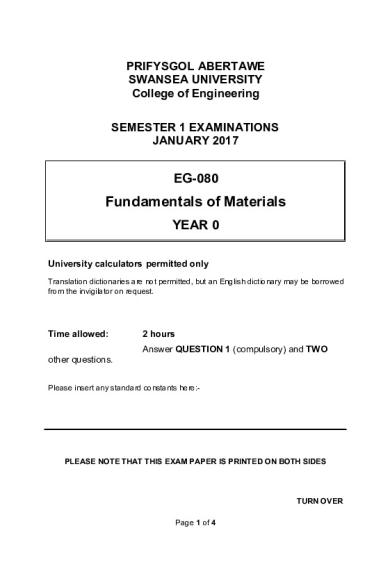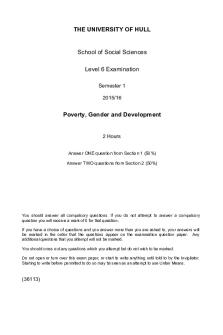Exam 2016, questions PDF

| Title | Exam 2016, questions |
|---|---|
| Course | Fundamentals of Materials |
| Institution | Swansea University |
| Pages | 4 |
| File Size | 95.8 KB |
| File Type | |
| Total Downloads | 106 |
| Total Views | 143 |
Summary
Download Exam 2016, questions PDF
Description
PRIFYSGOL ABERTAWE SWANSEA UNIVERSITY College of Engineering SEMESTER 1 EXAMINATIONS JANUARY 2017
EG-080
Fundamentals of Materials YEAR 0 University calculators permitted only Translation dictionaries are not permitted, but an English dictionary may be borrowed from the invigilator on request.
Time allowed:
2 hours Answer QUESTION 1 (compulsory) and TWO
other questions. Please insert any standard constants here:-
PLEASE NOTE THAT THIS EXAM PAPER IS PRINTED ON BOTH SIDES
TURN OVER Page 1 of 4
1. COMPULSORY – ANSWER ALL SECTIONS Write all your answers in the examination booklet, not on this paper. For questions (a) – (e), select the correct statement from options A, B, C or D. [2 marks each] (a)
Magnesium is a more brittle metal than Aluminium because:
A
Magnesium has fewer delocalised outer electrons than Aluminium
B C D
Magnesium is more reactive than Aluminium Magnesium has fewer slip systems than Aluminium Magnesium has a higher melting point than Aluminium
(b)
In the thermite reaction: 2Al + Fe 2 O 3 => Al 2 O 3 + 2Fe
A
Oxygen is the oxidising agent and Aluminium is the reducing agent
B C D
Iron is the oxidising agent and Aluminium is the reducing agent Aluminium is the oxidising agent and Iron is the reducing agent Oxygen is the oxidising agent and Iron is the reducing agent
(c)
Concrete can be given better frost protection by:
A B C D
Using more C2S and less C3A Using larger aggregate particles Increasing the water content in the mix Forcing additional air into the mix before setting
(d)
Catalytic converters reduce pollution by:
A B C
Removing sulphur oxides Oxidising nitrogen oxides and reducing carbon monoxide Reducing nitrogen oxides and oxidising carbon monoxide
D
Oxidising both carbon monoxide and nitrogen oxides
(e)
Thermosets are normally harder to process than thermoplastics because:
A B C D
They have higher levels of crystallinity They react with oxygen They have lower molecular weight They don’t melt reversibly TURN OVER Page 2 of 4
(f)
Write down the electron configuration for Zinc: Zn (30) [2 marks]
(g) Explain why Aluminium (Z = 13) has a larger atomic radius than Chlorine (atomic number 17). [3 marks] (h) Explain why calcium carbonate is added to a blast furnace for the extraction of iron. [3 marks] (i) Explain why aluminium is resistant to corrosion despite being more reactive than iron. [2 marks] (j) Explain why low density polyethylene is a weaker material than high density polyethylene. [3 marks] (k)
Explain why graphite can act as a solid lubricant. [2 marks] (TOTAL 25 MARKS)
OPTIONAL QUESTIONS: ANSWER TWO OF QUESTIONS 2-4. 2. Answer each of the following: (a)
List and explain 3 main properties of ionic solids based on the nature of ionic bonding. Give an example of an ionic solid and use diagrams to support your answer. [9 marks]
(b)
Describe covalent bonding and use a diagram to support your answer. Explain why diamond is brittle and cannot conduct electricity. [9 marks]
(c)
Explain why water is liquid in ambient conditions of pressure and temperature (P = 1 atm; T= 25 °C). Use a diagram to support your answer. [7 marks] (TOTAL 25 MARKS) TURN OVER Page 3 of 4
3. Answer each of the following: (a)
Explain what alloying refers to and why it may be useful. Describe the two main structural types of alloys. For each type of structure, provide an example of a metallic alloy and its application. [8 marks]
(b)
Explain why the extraction of aluminium cannot be carried out using the same process as in the extraction of iron. Describe the extraction process of aluminium from the bauxite ore discussing both the chemical and practical aspects of the extraction process. [10 marks]
(c)
Explain why corrosion is a major issue with steel but is less critical with aluminium and its alloys. Describe 3 methods commonly used to improve the corrosion resistance of steel. [7 marks] (TOTAL 25 MARKS)
4. Answer each of the following: (a)
Explain why concrete is weak in tension. Describe methods that can be used to strengthen it. [8 marks]
(b)
Describe the structure of a semicrystalline thermoplastic polymer. Discuss the factors affecting the crystallinity and how crystallinity influences the properties of the polymer. [9 marks]
(c)
Petrol engines produce a number of pollutants. Explain what these are and how their emissions can be minimised (write the relevant chemical reactions). [8 marks] (TOTAL 25 MARKS)
END OF PAPER Page 4 of 4...
Similar Free PDFs

Exam 2015 - 2016, questions
- 6 Pages

Exam January 2016, questions
- 4 Pages

Exam 2016, questions
- 18 Pages

Exam 2016, questions
- 6 Pages

Exam 2016, questions
- 29 Pages

Exam 2013-2016, questions
- 24 Pages

Exam 2016, questions
- 2 Pages

Exam June 2016, questions
- 7 Pages

Exam 2016, questions
- 6 Pages

Exam 2016, questions
- 2 Pages

Exam 2016, questions
- 9 Pages

Exam 2 2016, questions
- 6 Pages

Exam May 2016, questions
- 6 Pages

Exam October 2016, questions
- 26 Pages

Exam 2016, questions
- 2 Pages

Exam 2016, questions
- 3 Pages
Popular Institutions
- Tinajero National High School - Annex
- Politeknik Caltex Riau
- Yokohama City University
- SGT University
- University of Al-Qadisiyah
- Divine Word College of Vigan
- Techniek College Rotterdam
- Universidade de Santiago
- Universiti Teknologi MARA Cawangan Johor Kampus Pasir Gudang
- Poltekkes Kemenkes Yogyakarta
- Baguio City National High School
- Colegio san marcos
- preparatoria uno
- Centro de Bachillerato Tecnológico Industrial y de Servicios No. 107
- Dalian Maritime University
- Quang Trung Secondary School
- Colegio Tecnológico en Informática
- Corporación Regional de Educación Superior
- Grupo CEDVA
- Dar Al Uloom University
- Centro de Estudios Preuniversitarios de la Universidad Nacional de Ingeniería
- 上智大学
- Aakash International School, Nuna Majara
- San Felipe Neri Catholic School
- Kang Chiao International School - New Taipei City
- Misamis Occidental National High School
- Institución Educativa Escuela Normal Juan Ladrilleros
- Kolehiyo ng Pantukan
- Batanes State College
- Instituto Continental
- Sekolah Menengah Kejuruan Kesehatan Kaltara (Tarakan)
- Colegio de La Inmaculada Concepcion - Cebu